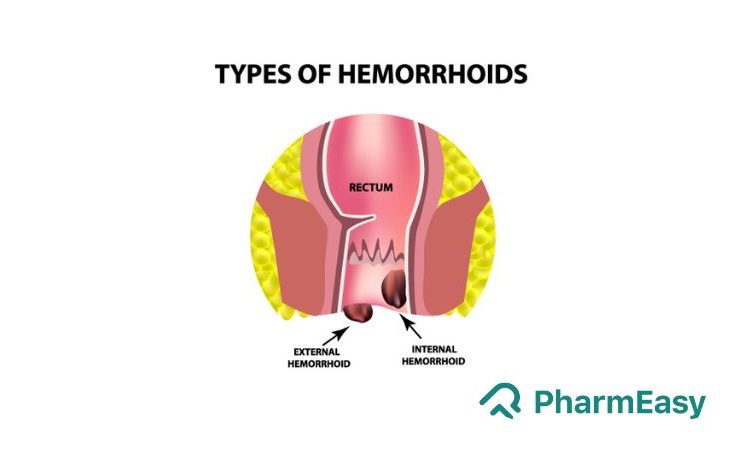Haemorrhoidectomy: Types, Procedure, Recovery and Risks
By Dr. Mayuri Pandey +2 more

Get,

to manage your symptom
Get your,


4 Cr+ families
benefitted

OTP sent to 9988776655



You’ve successfully subscribed to receive
doctor-approved tips on
Whatsapp

Get ready to feel your best.

Hi There,
Download the PharmEasy App now!!


Register to Avail the Offer
Send OTPBy continuing, you agree with our Privacy Policy and Terms and Conditions

Hi There,
Sign up on PharmEasy now!!
Trusted by 4 crore+ families

OTP sent to 9988776655



You have unlocked 25% off on medicines




Code: NU25
By Dr. Mayuri Pandey +2 more
Table of Contents
Haemorrhoidectomy is the surgical removal of haemorrhoids, commonly called piles. Haemorrhoids are a condition characterised by swollen veins in the anal and rectal region. Depending upon the location of haemorrhoids, these can be internal (inside the rectum) or external (around the anal opening. Haemorrhoids are managed using both non-surgical and surgical treatment along with lifestyle modifications. Usually, haemorrhoids which are recurrent, prolapsed (falling outside the rectum) and the ones which require reduction (shrinkage of haemorrhoidal mass) are often surgically removed by haemorrhoidectomy.1
Your doctor will take a detailed history and do a thorough physical examination before diagnosing haemorrhoids. He may do a digital rectal examination and a few imaging tests. Depending upon the type of haemorrhoid and the severity, he/she will decide the need for surgical excision of the haemorrhoid.1,2

Following are the indications for haemorrhoidectomy:1
Thrombosed haemorrhoids in which a blood clot is formed inside the haemorrhoid.2
Read More: 8 Best Home Remedies For Piles
In this section, we will look at the different types, procedures, available for haemorrhoidectomy:
Before performing haemorrhoidectomy, you will be given an enema for bowel clearance. It should not be painful but will make you little uneasy and uncomfortable. Haemorrhoidectomy procedures are carried out after anaesthetizing the patient with local anesthesia. The surgery procedure is usually carried out in prone jack-knife position, which requires you to lie on your stomach on a table which is flexed at 90 degrees. Your head and body will be lowered and your hips will be raised.1
The duration of hospital stay for stapled haemorrhoidectomy is one day; whereas conventional haemorrhoidectomy may require hospitalization for 6-7 days and the duration of laser surgery is short and requires no hospitalisation. As haemorrhoidectomy may require immobilization temporarily, you should always go to the hospital along with a family member or caretaker.5
Haemorrhoidectomy is contraindicated in the following conditions: 1
Haemorrhoids or piles can be managed using different treatment modalities. The surgical excision of haemorrhoids is called as haemorrhoidectomy. Different types include conventional haemorrhoidectomy (open and close), laser, LigaSure, cryosurgical, stapled haemorrhoidectomy, etc. Each type has its own benefits and risks. Your doctor or proctologist will assess the need of the surgery and weigh the benefits against the risks involved.
Haemorrhoidectomy is the surgical removal of haemorrhoids.
Yes, haemorrhoidectomy is associated with post-operative pain; but you need to worry your doctor will prescribe painkillers for managing pain.3
The different types of haemorrhoidectomy including open, closed, laser, LigaSure, stapled, cryosurgical, harmonic ultrasonic scalpel, clamp and cautery, submucosal, whitehead’s circumferential, bipolar diathermy LigaSure and Starion haemorrhoidectomy types.4
Haemorrhoidectomy is contraindicated in uncontrolled bleeding disorders, portal hypertension, Ulcerative colitis or Crohn’s disease, faecal incontinence (not able to control bowel movements) or any medical condition which makes the patient unable to undergo anesthesia.1
Haemorrhoidectomy may increase the risk of urinary retention, pain, thrombosed haemorrhoid and bleeding.1
Disclaimer: The information provided here is for educational/awareness purposes only and is not intended to be a substitute for medical treatment by a healthcare professional and should not be relied upon to diagnose or treat any medical condition. The reader should consult a registered medical practitioner to determine the appropriateness of the information before consuming any medication. PharmEasy does not provide any guarantee or warranty (express or implied) regarding the accuracy, adequacy, completeness, legality, reliability, or usefulness of the information; and disclaims any liability arising thereof.
Links and product recommendations in the information provided here are advertisements of third-party products available on the website. PharmEasy does not make any representation of the accuracy or suitability of such products/services. Advertisements do not influence the editorial decisions or content. The information in this blog is subject to change without notice. The authors and administrators reserve the right to modify, add, or remove content without notification. It is your responsibility to review this disclaimer regularly for any changes.

Leave your comment...
Comments